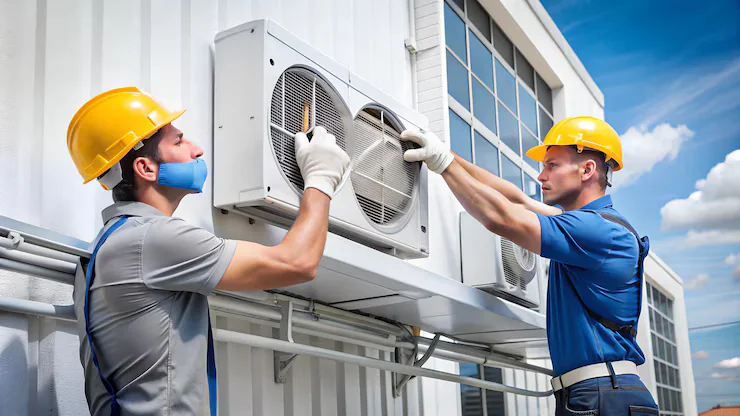When it comes to installing an air conditioning system in your home or business, making the right choice can feel overwhelming. With various systems available, each offering different advantages, it’s essential to understand the types of air conditioning installations you can choose from. The right system can greatly improve your indoor comfort, save on energy costs, and provide long-term reliability. In this comprehensive guide, we will dive into the different types of air conditioning installation options available, explaining their benefits and helping you make an informed decision.
Table of Contents
- Central Air Conditioning Systems
- Ductless Mini-Split Air Conditioners
- Window Air Conditioners
- Portable Air Conditioners
- Hybrid Air Conditioners
- Geothermal Air Conditioners
- Conclusion: Choosing the Right AC System for Your Home
- Spring, TX Air Conditioning Installation from KAC Express
1. Central Air Conditioning Systems
What Is It?
Central air conditioning is one of the most common types of air conditioning systems used in homes. It cools the air through a centralized unit and distributes it throughout the house via ductwork and vents.
How It Works
A central AC system works by pulling warm air from the house through return ducts. The air passes through filters to remove dust and dirt, then moves over refrigerant-filled coils to cool it down. The cooled air is then distributed back into the house through a network of ducts.
Pros:
- Whole-House Cooling
- Energy Efficiency
- Aesthetically Pleasing
Cons:
- Ductwork Needed
- Higher Upfront Costs
2. Ductless Mini-Split Air Conditioners
What Is It?
Ductless mini-split systems consist of an outdoor unit and one or more indoor units mounted on walls. They operate without ductwork, making them ideal for homes where duct installation is not possible.
How It Works
The outdoor compressor unit connects to the indoor air-handling units via a small conduit that contains refrigerant tubing, power lines, and a condensate drain. Each indoor unit can be controlled individually, allowing for customizable temperature zones in different rooms.
Pros:
- No Ductwork Required
- Energy Efficiency
- Zoned Cooling
Cons:
- Higher Installation Costs
- Aesthetics
3. Window Air Conditioners
What Is It?
Window air conditioners are self-contained units that fit into a window or a hole in a wall. These are common in apartments and small spaces where central air or ductless systems may not be feasible.
How It Works
A window air conditioner takes in warm air from the room, cools it down, and pushes it back into the space. The warm air is expelled outside through the back of the unit.
Pros:
- Low Cost
- Ideal for Small Spaces
- Portable
Cons:
- Limited Cooling Capacity
- Affects Aesthetics
4. Portable Air Conditioners
What Is It?
Portable air conditioners are freestanding units that can be moved from room to room. These are perfect for renters or anyone who needs temporary cooling solutions.
How It Works
Portable units pull air from the room, cool it, and then release the cooled air back into the room. They typically require venting through a window or a wall.
Pros:
- Portability
- Easy Installation
- Great for Renters
Cons:
- Limited Cooling
- Noisy
- Less Efficient
5. Hybrid Air Conditioners
What Is It?
A hybrid air conditioning system alternates between electricity and gas to maximize energy efficiency. It combines a traditional air conditioner with a heat pump, which switches between heating and cooling modes.
How It Works
During warmer months, the system works like a standard AC unit, using refrigerant to cool the air. When the weather gets colder, it switches to a heat pump, drawing heat from the outside air to warm the home.
Pros:
- Energy Savings
- Environmentally Friendly
Cons:
- Higher Upfront Cost
- Complexity
6. Geothermal Air Conditioners
What Is It?
Geothermal air conditioning systems utilize the Earth’s stable underground temperatures to heat and cool homes. They are among the most energy-efficient and environmentally friendly options available.
How It Works
A geothermal system consists of underground loops filled with fluid that absorb heat from the ground during the winter and release heat during the summer. The system transfers this heat to or from your home via a heat pump.
Pros:
- Highly Energy Efficient
- Environmentally Friendly
- Long Lifespan
Cons:
- High Initial Cost
- Installation Requirements
Conclusion: Choosing the Right AC System for Your Home
The type of air conditioning installation you choose will depend on several factors: the size of your home, your budget, energy efficiency goals, and whether you want a system that can cool the entire house or just individual rooms. Whether you opt for a central air system, a ductless mini-split, or a geothermal system, understanding the pros and cons of each type will help you make an informed decision.
Spring, TX Air Conditioning Installation from KAC Express
If you’re in Spring, TX, and looking for expert advice and professional air conditioning installation, KAC Express is here to help. With years of experience in the HVAC industry, we offer tailored solutions to meet your specific needs. Our team specializes in installing a wide range of air conditioning systems, from energy-efficient central AC units to ductless mini-splits, ensuring you get the perfect system for your home.
At KAC Express, we understand that every home is different, which is why we provide customized recommendations and top-tier customer service. When you choose us, you’ll benefit from high-quality installations, reliable service, and energy-efficient solutions that keep your home comfortable all year long.
Ready to upgrade your air conditioning system? Contact KAC Express today to schedule your consultation and discover the best options for your home in Spring, TX!


0 Comments